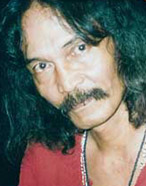 |
||
|---|---|---|
| CP Foundation | About CP Biennale | 2003 | 2005 | Contact Us | >||
           
|
||
|
Since 1985, when Hari Pochang founded the Forum Fotografi Bandung (Bandung's Forum on Photography) he has contemplated the difference between photography as aesthetic medium of expression, and photography as autonomous work and practice equaling an artist's work. Pochang made his concern known in 1986 the Forum Alternatif (Alternative Forum) photo-exhibition in Bandung. But the discourse on photography in Indonesia remained divided between "salon photography" and photography for photography's sake. The problem more or less began when photography in the archipelago was used as a medium to document social and anthropological artifacts. The history of photography in Indonesia is closely related to the name of Kassian Cephas, a Javanese photographer, whose oldest work dated 1875 was traced and it became known that Cephas was a photographer for the royal courts and sultanates in Java. Together with some Dutchmen, Cephas recorded the various "faces" of the people in The Indies. Photography was in Indonesia also became more a tool to record certain events during the physical revolution. Some among these may have been no more than just efforts to document sites of cultural or historical significance. Such tendency has more or less affected the Indonesian photographer in making photography commercial, journalistic, or to help document Indonesia's cultural realms. The period between 1994 and 1997 was marked by going around Indonesia to make photographs of the various ethnic cultures of the Indonesian archipelago. This he did after he came back from New York where he held an exhibition and a slide show of his works. Hari Pochang thought of these journeys as his quest for identity, not only in the realm of images, but also in terms of the Indonesian photographic practice. At the same time, Hari Pochang seemed to be tracing the footsteps of his predecessors. It became clear that the perspective of the eye, the way one photographer looks or sees an object could be very different from another photographer's way of seeing the same object. For Hari Pochang, the value of a picture tended to be established at will, both socially and culturally. He quietly engineered aesthetics. Pochang realizes that the camera is a device to fulfill his desire to produce and reproduce images, whenever and wherever he likes. The camera seems to be an inseparable part of his life. Many of the pictures were taken with natural lighting of the moment and no previous preparation. Gradually, however, Pochang's photographic skills in painting with light came to fuse with his desire of creating a work of represention. His last work (2002) revealed Pochang's effort to muffle the journalistic aspect of photography in order to put more emphasis on the autonomous creative process with its different textual readings. Born on April 25, 1951 in Bandung. SELECTED EXHIBITIONS AND ACTIVITIES |
||
|
CP Foundation | About CP Biennale | 2003 | 2005 | Contact Us
Jl. Suryopranoto 67A, Jakarta 10160, Indonesia. ph. +62.21.3448126, 3853206 | fax. +62.21.3853203, 3853208 info@cp-foundation.org |
||
 In Bandung, Hari Krishnadi is not only known as a musician, for since 1982, he has also been actively involved in photography. In his latest exhibition which was held in late 2002, Hari Krishnadi - or Hari Pochang, as he is popularly known - mulled over the much disputed issue of art and photography: when can a photograph be considered a work of art the way the art world views paintings as a works of art, the quiescent dilemma between photography as a work of art or art as photography.
In Bandung, Hari Krishnadi is not only known as a musician, for since 1982, he has also been actively involved in photography. In his latest exhibition which was held in late 2002, Hari Krishnadi - or Hari Pochang, as he is popularly known - mulled over the much disputed issue of art and photography: when can a photograph be considered a work of art the way the art world views paintings as a works of art, the quiescent dilemma between photography as a work of art or art as photography.